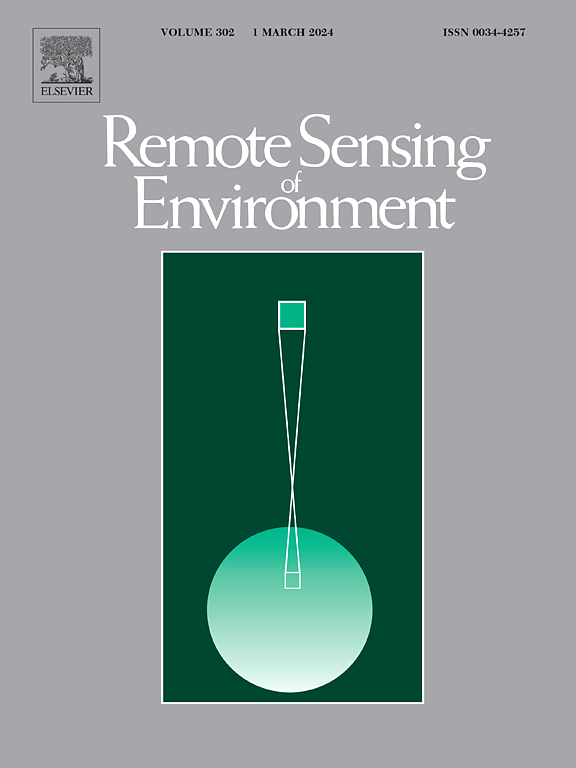利用PACE多角度偏振法推导上升流辐射的各向异性校正
IF 11.1
1区 地球科学
Q1 ENVIRONMENTAL SCIENCES
引用次数: 0
摘要
NASA的浮游生物、气溶胶、云、海洋生态系统(PACE)任务于2024年2月8日发射,携带一个高光谱辐射计、海洋颜色仪器(OCI)和两个多角度偏振仪,超角彩虹偏振仪(HARP2)和行星探测一号光谱偏振仪(spex - 1)。这些传感器的同时部署提供了一个前所未有的机会,可以获得更精确的双向因子,用于校正OCI遥感反射率对太阳传感器观测的依赖。利用基于准单散射近似辐射传递方程的双向遥感模型,从HARP2的多角度观测中推导出反向体积散射函数(VSF)的角形,即粒子的χ因子(χp)。导出的χp反过来用于驱动双向遥感模型来预测双向因子。对发射前模拟的HARP2 L1C数据进行测试,其中包括由于大气校正造成的不确定性,该方法可以在HARP2的任意三个可见波段估计双向因子,不确定性为10%。由于所提出的方法直接从多角度观测中估计χp,因此它充分考虑了VSFs的自然变异性,而在早期的双向校正模型中,VSFs被认为局限在有限的变化范围内。本文章由计算机程序翻译,如有差异,请以英文原文为准。
Deriving anisotropic correction for upwelling radiance from PACE's multi-angle polarimetry
NASA's Plankton, Aerosol, Clouds, ocean Ecosystem (PACE) mission, launched on 8th February 2024, carries a hyperspectral radiometer, Ocean Color Instrument (OCI) and two multi-angle polarimeters, Hyper Angular Rainbow Polarimeter (HARP2) and Spectro-Polarimeter for Planetary Exploration one (SPEX-one). The simultaneous deployment of these sensors offers an unprecedented opportunity to derive more accurate bidirectional factors for correcting the Sun-sensor viewing dependence of the remote sensing reflectance derived from OCI. With a bidirectional remote sensing model based on quasi-single-scattering approximation to the radiative transfer equation, the angular shape of the volume scattering function (VSF) in backward directions, i.e., the χ factor for particles (χp) is derived from the multi-angle observation of HARP2. The derived χp is in turn used to drive the bidirectional remote sensing model to predict the bidirectional factor. Testing with prelaunch simulated HARP2 L1C data that includes uncertainties due to atmospheric correction, the proposed method can estimate bidirectional factor with an uncertainty <10 % at any three visible bands of HARP2. Because the proposed method estimates the χp directly from the multi-angle observation, it fully accounts for the natural variability of VSFs, which were assumed to confine within a limited range of variation in the earlier bidirectional correction models.
求助全文
通过发布文献求助,成功后即可免费获取论文全文。
去求助
来源期刊

Remote Sensing of Environment
环境科学-成像科学与照相技术
CiteScore
25.10
自引率
8.90%
发文量
455
审稿时长
53 days
期刊介绍:
Remote Sensing of Environment (RSE) serves the Earth observation community by disseminating results on the theory, science, applications, and technology that contribute to advancing the field of remote sensing. With a thoroughly interdisciplinary approach, RSE encompasses terrestrial, oceanic, and atmospheric sensing.
The journal emphasizes biophysical and quantitative approaches to remote sensing at local to global scales, covering a diverse range of applications and techniques.
RSE serves as a vital platform for the exchange of knowledge and advancements in the dynamic field of remote sensing.
 求助内容:
求助内容: 应助结果提醒方式:
应助结果提醒方式:


